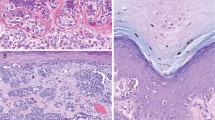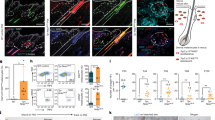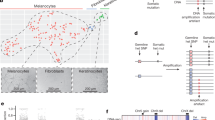Abstract
IN skin of the Syrian golden hamster, clusters of pigmented dendritic cells are found occasionally around certain hair follicles1. These areas of pigment are visible to the eye as small black spots. Ghadially and Barker1 consider these clusters of pigmented cells to be normal, not nevi, and their studies of skin treated repeatedly with 9,10-dimethyl-1,2-benzanthracene (DMBA) indicate that melanotic tumours arise at these particular sites.
This is a preview of subscription content, access via your institution
Access options
Subscribe to this journal
Receive 51 print issues and online access
$199.00 per year
only $3.90 per issue
Buy this article
- Purchase on Springer Link
- Instant access to full article PDF
Prices may be subject to local taxes which are calculated during checkout
Similar content being viewed by others
References
Ghadially, F. N., and Barker, J. F., J. Path. Bact., 79, 263 (1960).
Straile, W. E., Amer. J. Anat., 106, 133 (1960).
Straile, W. E., Amer. J. Anat., 109, 1 (1961).
Simpson, W. L., and Cramer, W., Canad. Res., 3, 362 (1943).
Nakai, T., and Rappaport, H., in Nat. Cancer Inst. Mon. No. 10, edit. by Urbach, F., 297 (U.S. Government Printing Office, Washington, 1963).
Author information
Authors and Affiliations
Rights and permissions
About this article
Cite this article
STRAILE, W. Carcinogen-induced Melanotic Tumours of the Tylotrich (Hair) Follicle. Nature 202, 403–404 (1964). https://doi.org/10.1038/202403a0
Issue Date:
DOI: https://doi.org/10.1038/202403a0
This article is cited by
-
Experimentally-Induced Neoplasms in the Skin of Mice
Journal of Investigative Dermatology (1965)
Comments
By submitting a comment you agree to abide by our Terms and Community Guidelines. If you find something abusive or that does not comply with our terms or guidelines please flag it as inappropriate.



